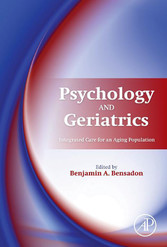
Psychology and Geriatrics - Integrated Care for an Aging Population
von: Benjamin A. Bensadon
Elsevier Reference Monographs, 2015
ISBN: 9780124201811
Sprache: Englisch
280 Seiten, Download: 2785 KB
Format: EPUB, PDF, auch als Online-Lesen
Goal-Oriented Care
Susan L. Charette, Maristela Baruiz Garcia and David B. Reuben, University of California, Los Angeles, California, USA
Inspired in part by psychologists’ concept of goal attainment scaling nearly 50 years ago, this chapter describes a practical, patient-centered, goal-oriented model of geriatric medical care. This customized care approach requires clinicians to be aware of and able to set aside their own, personal preferences and values in order to more actively attend to those of their patients, many of whom live with multimorbidity. Benefits and barriers to implementing this paradigm shift from disease to patient focus are addressed, and possible solutions are offered.
Keywords
Patient-physician communication; goal-oriented medical care; shared decision making; multimorbidity; patient-centered medical care
Introduction
As a result of better public health and nutrition and improved treatment of disease, Americans are living longer with more chronic conditions. Although many older persons have aged with few illnesses and good functional status, over 70% have two or more chronic conditions (Anderson, 2010). The term “multimorbidity” has been coined to describe this trend, which is associated with higher rates of death, disability, adverse effects, institutionalization, use of health care resources, and poorer quality of life (American Geriatrics Society Expert Panel on the Care of Older Adults with Multimorbidity, 2012). These patients are also at increased risk of adverse effects of medical therapy (Fried, Tinetti, Agostini, Iannone, & Towle, 2011).
Although clinical practice guidelines (CPCs) have been developed to guide the care of specific individual diseases, this management approach may be problematic when several conditions with competing guidelines are present (Boyd & Fortin, 2011; Tinetti, Fried, & Boyd, 2012). Nevertheless, to date, the Centers for Medicare and Medicaid Services (CMS) have focused on evaluating preventive measures (e.g., bone mineral density) and quality indicators for specific disease management (e.g., frequency of measurement of glycohemoglobin and blood glucose control). It has been suggested, however, that quality of care goes much further than just meeting individualized disease quality metrics.
In its 2001 report Crossing the Quality Chasm: A New Health System for the 21st Century, the Institute of Medicine (IOM) recommended a shift to patient-centered medical care. At its core, this approach is respectful of and responsive to individual patient preferences, needs and values, and ensures that patient values guide all clinical decisions. Meeting this challenge requires that health providers are cognizant of the patient’s values as they determine preferences and goals in the face of changes in health status. This shifts the framework of treating illnesses as purely biomedical processes to approaching them in the context of psychosocial factors that have a dynamic influence on the individual’s personal health goals.
Patient-centered care can be disease-specific by incorporating the principles above into treatment decisions for the disease. With multimorbidity, however, it is more difficult to provide disease-specific patient care without considering the context of other illnesses. Hence, the disease paradigm is an insufficient model to guide treatment. The practice of prioritizing patients’ health goals and moving away from disease-directed care is foreign territory for most physicians. Thus patient-centered care requires physicians to use a skill set and approach with which they may be both unfamiliar and uncomfortable.
Goal-setting is a useful alternative to the traditional disease-focused approach in the care of older adults and is more likely to achieve patient-centeredness in medical encounters (Reuben & Tinetti, 2012). Far from a new concept, the important link between motivation and goal-setting has been discussed in the field of psychology for half a century (Locke & Latham, 2002).
Since the 1960s, psychology and several other health care disciplines, most notably physical rehabilitation and palliative care, have described and incorporated a different paradigm to guide decision-making through goal-oriented care. Goal-setting stems from the theory of self-efficacy, which refers to peoples’ beliefs in their ability to achieve a goal; that is, the more they believe they will be successful (high self-efficacy), the more likely they will do what is necessary to achieve their goal (Bandura, 1977).
In physical rehabilitation programs, goal-setting is integral to the collaborative development between the patient and the rehabilitation team of individualized, realistically attainable treatment goals. Perception is a key to success. Patients are more likely to participate in the rehabilitation process if they perceive the treatment goals as being personally relevant. Similarly, goal-directed psychotherapy involves the sequential identification of first, the foci of treatment (i.e., problems) derived from the diagnoses; second, the development of actionable goals and objectives and the selection of the treatment plan; third, an estimate of the time required to attain the goals using available resources, and fourth, the subsequent monitoring mechanisms to evaluate treatment effectiveness until the treatment is terminated (Nurcombe, 2008). Goal-directed therapy in this setting has the advantage of providing a useful framework within which effectiveness of treatment plans or lack thereof can be assessed.
Another example of goal-setting that has become widely accepted is known as goals-of-care discussion, when a patient has a terminal or advanced illness, and decisions are being made whether to continue treatment or consider palliative care and hospice. This process can be incorporated into the care of multimorbid patients, who are often faced with making decisions among many options while weighing the pros and cons of various choices. The goals-of-care discussion should be part of routine care and should address basic patient preferences, including goals for their health, physical function, and life. These conversations can serve as a map that enables patients and practitioners to collaboratively navigate the health care journey.
Incorporating patient-centered goal-setting in the care of older adults involves considerations that go well beyond evidence-based management of specific diseases. It recognizes the current limits of medical science, including prognostic uncertainties, tradeoffs, and the lack of evidence-based data to guide treatment of multimorbidities. More importantly, patient-centered goal-setting restores emphasis on the patient’s values and preferences as a guide to care and responds to the individual’s ability to adapt to changes in health status as they arise. Individualized goal-setting acknowledges that perceptions of “quality of life” (QoL) may vary among different individuals. Moreover, it recognizes that a person’s QoL standard may change over time as that person’s health trajectory unfolds and as he or she copes with the experience of new disease or health states.
In goal-oriented care, an outcome may not be a cancer remission or cure of an infection, but rather the reaching of a milestone (e.g., attending a graduation or celebrating an anniversary), improving symptoms (e.g., reduced pain or shortness of breath), or achieving the ability to complete an activity with less effort or help.
Goal-Oriented Care: A Practical Approach
A patient-centered approach that focuses on the individual’s personal health goals requires a fundamental understanding of the older adult’s values, objectives, and health-related expectations. It also necessitates clarifying which of multiple medical conditions to address and how these comorbidities and their respective treatments affect one another. This approach considers what “quality” and “beneficial” care mean to the individual, and aligns treatment plans that will most likely contribute positively towards the patient’s desired outcomes. To be effective, clinicians must set aside their personal preferences and interests and listen actively to identify those of their patients. This is a trainable skill set.
Preparation for goal-oriented visits may include a review of the results of recent studies and the recommendations of specialists. This information is helpful in assessing the patient’s current health status and determining prognosis. Predicting an older adult’s health trajectory involves drawing upon clinical experience and epidemiologic data on life expectancy. Life expectancy tables include a wide range for individuals 65 years and older. The clinician’s assessment of the patient’s overall health status as being above (75th percentile), at (50th percentile), or below (25th percentile) average for age and sex is an important consideration. Overall health status is largely influenced by the presence of comorbidities and functional status (Arias, 2012; Reuben et al., 2012). Additionally, life expectancy is consistently associated with sociocultural factors such as race, education level, and economic status (Reuben et al., 2012). This background knowledge enables the health care provider to better frame decisions for treatment of existing diseases and for disease prevention strategies.
To provide goal-oriented care, clinicians should start each visit by exploring the patient’s priorities...










